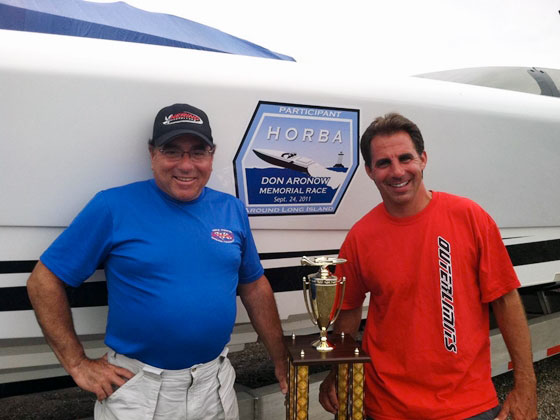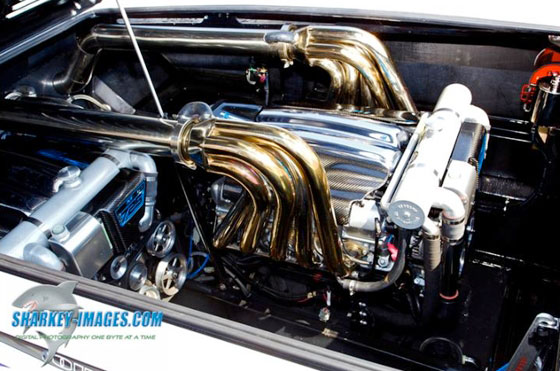Offshore Endurance Racing: Making a Comeback?
New interest in an old format is on the rise.
The first time I met Joe Cibellis was at the 2011 Desert Storm Poker Run on Lake Havasu in Arizona. Cibellis, who owns a 43-foot-long Outerlimits V-bottom with twin 725-hp Ilmor Marine V-10 engines, was a long way from his Hampton Bays, Long Island, N.Y. home, but he’d always wanted to do a little high-performance boating west of the Mississippi. Save for his getting rear-ended by a gravel truck somewhere in Alabama as he towed his boat across the country, he had a great time.

Joe Cibellis and Joe Sgro used this 43-foot Outerlimits to set a new around Long Island record of 3 hours and 5 minutes. Photo by Tim Sharkey
Earlier in the year, I’d seen Cibellis’ elegant 43-footer at the Miami Boat Show Poker Run, and frankly I was blown away. I’ve seen dozens of Outerlimits over the years—company owner Mike Fiore and his crew always do a fine job with their custom creations—but this one was special. It was a simple, white-and-gray sit-down model with twin naturally aspirated engines color-matched in the same understated hues.
“I had it built to be reliable, first and foremost,” Cibellis told me when I finally met him at Desert Storm. “I do a lot of boating, like 250 hours a year, and I don’t want any problems. I don’t have to do anything to this boat.”
Cibellis got a chance to show exactly how reliable—and efficient—his boat is when he entered the second Don Aronow Around Long Island Memorial Race in 2011. And with his friend Joe Sgro, a veteran offshore racer, he not only won the event but set a new record for the 270-mile course with a time of three hours and five minutes and an average speed of more than 90 mph. Cibellis and Sgro bested five other teams to take the title.

Joe Sgro (left) and Joe Cibellis with Don Aronow Memorial Around Long Island race trophy.
“For me, 270 miles is not that far to go,” said Cibellis when I spoke with him a week after the event. “I mean, it’s far to go when you’re running fast, but I do a lot of boating during the season so I’m used to long runs.”
Cibellis said the length of the run actually is what drew him to it. Unlike most of today’s closed-course offshore powerboat races that run multiple laps on 6- to 12-mile near-shore courses, the Long Island run was a true offshore event. Such events defined offshore racing in 1970s, but were mostly replaced by closed-course racing in 1980s, and were all but gone by the 1990s.
Then two years ago, they began to reappear.
“These events take a little bit of everything, but being patient is the most important thing,” said Cibellis. “You run fast when you can, but you have to slow down when you need to. Fuel economy also regulates how fast you can go. All around, there’s a lot to it.”
To that end, Cibellis and Sgro, knowing they had no shot at breaking the existing record if they made a fuel stop, placed two 44-gallon fuel tanks—with electric pumps connected to the boat’s fuel system—in the rear of the cockpit.
“In 270 miles we burned 270 gallons of fuel,” he said. “That’s one mile per gallon, which is pretty efficient. And the motors ran perfectly. They didn’t miss a beat.”
The online message boards including those at offshoreonly.com lit up with the news of the event, and the accomplishment of Cibellis and Sgro, moments after they finished. Speedonthewater.com ran a commentary by longtime industry observer Rich Luhrs titled, “Endurance Event Presents a ‘New Model’ for Offshore Racing.”
Luhrs wrote, “The turnout doubled last year’s boat count and indicates that there may be a burgeoning demand and interest for such throwback events, in an era that has seen offshore racing migrate away from big water, long-distance races to closed courses on brackish bays, rivers, and inland lakes.”
At present, there are two domestic offshore powerboat racing endurance events that you could call annual—each has now been run twice. In the spring, there’s the Bimini Offshore Challenge, which is a race from Miami to Bimini and back. The second is the Long Island event.

Twin 725-hp Ilmor Marine V-10 naturally aspirated engines provided power for the boat. Photo by Tim Sharkey.
To date, the biggest challenge for both events has been scheduling. In a season full of poker runs and offshore races, finding an event-free weekend is difficult at best. For the Bimini run, the solution for 2012 is to move from mid June to late May. To help their cause, the organizers of the Long Island Race have already set their date—September 22—for next year.
While neither of the runs attracted a double-digit fleet, both created more online buzz in the high-performance powerboat community than any closed-course, near-shore offshore race in recent history. Clearly, the events sparked the imagination of high-performance boat enthusiasts, most of whom have little to no interest in today’s version of offshore racing. Clearly, the organizers are onto something.
Don’t bet against each event doubling its fleet size in 2012.
As for Cibellis, he’s looking forward to next year—but he’s not waiting for it to get back on the water. In fact, the day after the event, he and Sgro were supposed to make a lunch run on the 43-footer that, less than 24 hours before, had set a new record.
“The weather turned, so we didn’t go,” said Cibellis. “But we were going to. Like I said, I do a lot of boating.”
Captions
-
-
-












